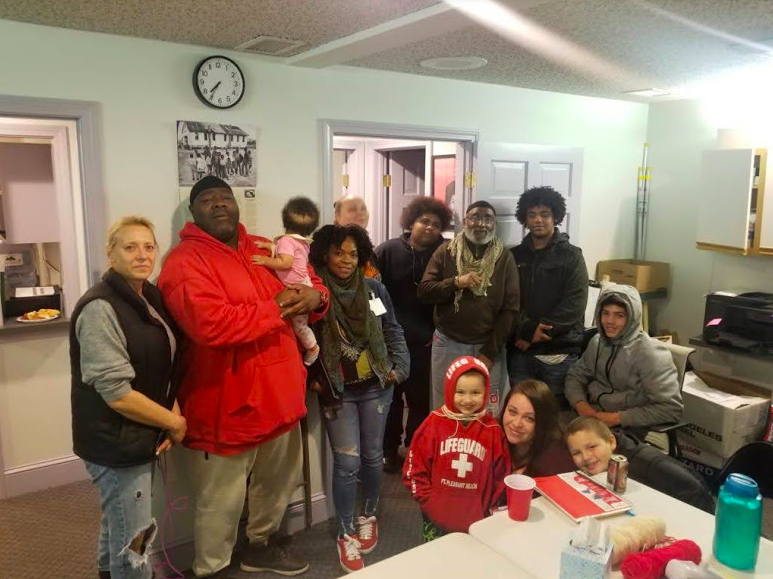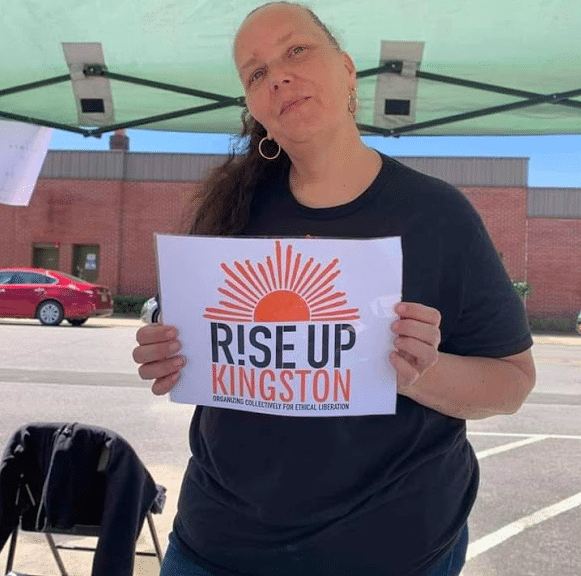
Two decades after schools across the country beefed up police presence on campus in response to the mass shooting at Columbine High, the uprising over the killing of George Floyd has prompted communities small and large to rethink that trend in the name of racial justice.
And as large school districts from Minneapolis to Seattle and Los Angeles have voted police forces off their campuses, lesser-known debates are underway in small-town America: “Do police generate safety in schools? Or do they perpetuate the school-to-prison pipeline for students of color?”
Those are the questions they’re asking, said Maria Fernandez, senior campaign strategist with the Advancement Project, a national group pushing to remove police from schools.
In New York, that debate has been heated this spring in the mid-Hudson Valley city of Kingston, which has worked to comply with Democratic Gov. Andrew Cuomo’s order that every jurisdiction in the state evaluate its law enforcement agency’s policies for racial bias and come up with an improvement plan by April 1.
In the K-12 Kingston City School District, on one side are parents who say police unfairly drive Black and brown students into the criminal justice system. On the other are parents and teachers who argue that police offer kids protection from bullying, the terror of mass shootings and other threats in a city that’s experienced a surge in gun violence in the last 18 months.
Both sides in Kingston agree officers shouldn’t be involved in everyday school discipline. But that’s where they part ways.
“I was comfortable, ignorant, baking cookies with my grandchildren, ignoring the problems that were happening in the world because I felt like my voice really didn’t matter,” said one local activist, Lisa Royer.
Then, three years ago, two school police officers stopped Royer’s 16-year-old biracial daughter Aleesa Jordan and a friend a mile from Kingston High School. Jordan was arrested for being “disorderly” and her friend, who is Black, for trespassing at the high school, according to reporting by Kingston’s Daily Freeman.

Outrage over the arrests was in part what led Royer to help establish a local activist group, Rise Up Kingston. Last summer the group launched a petition signed by more than 1,800 people calling for an end to Kingston City School District’s agreement with the Police Department. Supporters want the district to reinvest money spent on police into additional school counselors.
That petition brought an equally energetic response from another local community group that wants school resource officers, as the police are known, to stay on campus. Kingston Action for Education started its own petition, “Advocating to Keep Our SROs,” which was signed by more than 1,400 people.
“In a world full of political extremes, riots and a global pandemic, our children need as much support as possible,” that group’s petition states.
Those involved with the effort say officers don’t discipline students, and only step in to stop illegal activity. One supporter, a teacher in the district and a parent of two students, submitted written comments for a citywide Feb. 11 Zoom meeting, stating that she’d never heard of school police causing any student trauma. In another written comment, a supporter of school police noted that her seventh-grade daughter had been the target of bullying, which stopped when a school officer got involved.
***
The first police showed up in schools in the 1950s as a way to improve relations between students and officers. Still, by 1975 only a few schools had them: About 1% of principals reported having an officer stationed at their school, according to a 1978 report by the National Institute of Education, a one-time federal agency.
But in response to rising youth crime in the 1980s, lawmakers set aside a flow of federal money under the 1994 Violent Crime Control and Law Enforcement Act to place more officers in schools. That became a flood after the Columbine shooting in 1999, when more than 6,500 officers were hired with additional funding from the U.S. Department of Justice. By the 2007-2008 school year, 40% of principals reported police were stationed at their schools.
The reversal began as history shifted, yet again, in the weeks after Floyd’s killing by a white Minneapolis police officer prompted international protests against racism and police brutality. Since then, at least 16 school districts across the U.S. have ended their contracts with police, including in Rochester in western New York.

The Kingston City School District – whose student body was 13% Black in the 2018-2019 school year – has yet to decide.
Earlier this year, a city-appointed task force responded to the governor’s June order to rethink policing, offering up a dozen recommendations in a 200-page report. The public was allowed to comment on the Feb. 11 Zoom call. At the meeting, one proposal – revising the school district’s agreement with the Police Department and perhaps ending it entirely – consumed the entire meeting.
The task force’s recommendation was to keep police in the schools for the time being, but under stricter controls. It calls for amending the district’s agreement with local police so students won’t be criminally prosecuted for offenses that represent developmentally appropriate behavior. It also advises additional restrictions on restraint methods and requires data collection to ensure that the new standards are being followed.
If none of that happens within a year, the task force recommends canceling the agreement and entirely removing officers from the three Kingston school campuses where they’re now stationed.
It’s not clear the district will take that advice. Neither the superintendent nor a school board member referred by the superintendent responded to several requests for comment about next steps.
Kingston Mayor Steve Noble told The Imprint he wouldn’t oppose a decision to keep officers on school campuses, responding through a spokesperson that as long as the Kingston City School District “continues to want to have SROs, we will continue to assist them in that endeavor.”
Central to the issue in Kingston and elsewhere are allegations of racism in school discipline. In 2015, Black students made up about 15% of the Kingston district’s roughly 6,200 students, but 32% of in-school suspensions, 36% of out-of-school suspensions, and 56% of expulsions, according to the task force report.
Nationally, at least two studies since 2015 have found that teachers and principals employ harsher discipline against Black students than white students when they are misbehaving in identical ways.
“Absolutely race is a factor in these conversations,” said Fernandez. “Because we know that Black youth are disproportionately impacted.”
Meanwhile, a study published in February questions the original premise of adding more police in schools: stopping mass shootings. Three criminal justice researchers looked at every case from 1980 to 2019 in which one or more people were shot in a school building during the school day, 133 cases in all. The number killed was almost three times higher when an armed officer or guard was present. In explanation, the researchers cited previous studies suggesting that many school shooters are suicidal, so an armed officer serves as an incentive, not a deterrent.
In Kingston, the parent and community groups disagree on whether police provide protection or represent a threat.

Cherelyn Volpert, a school counselor at Bailey Middle School in the district, said she’d heard from high school staff that a former student of hers with serious mental health issues brought a weapon to school – though not a gun – and a school officer was able to take the weapon away.
“He probably saved the student’s life and potentially saved others from being hurt,” Volpert said.
But then there’s KayCee Wimbish, parent of a Bailey fifth grader. Although classes have been mostly virtual this year, when they’ve been held on campus, she said her child – who is in his first year of middle school – has been “horrified” to see armed police at his school for the first time.
“He’s terrified of guns and will cross the street to get away from the police because he just doesn’t want to be near a gun,” Wimbish said. “Now there’s one in his school.”
Wimbish said white people who support police on campus don’t understand how officers generally treat people of color. “Their experience is very, very different,” she said. “It’s hard because mostly I feel like that’s a very white-privileged point of view.”
Kingston Action for Education did not respond to multiple requests for comment posted on the group’s Facebook page.
Other cities in New York have already taken steps to remove school police as part of their local reform efforts, including the city of Albany, whose school district is 46% Black. Albany’s working group has recommended eliminating school officers, amid little public opposition. And at least two other jurisdictions – the village of Ossining and the city of Syracuse – responded to opposition from the community and students of color by pledging to re-evaluate the continued use of school police.
In an interview with The Imprint, Royer said the arrest of her daughter by officers she believes were school police had a lasting impact.
The Kingston City Court has sealed the arrest record, so the Police Department said it could not answer questions about the case.
But as Royer described it, her daughter and friend were arrested for not cooperating in identifying students involved in a fight on school grounds that the two had witnessed that afternoon. Royer said the officers tracked down the pair while they were walking to work, to ask where the perpetrators had gone. Because they refused to say, the officers arrested Jordan’s friend, who wasn’t a student, on a technicality: stepping onto the school lawn while she was passing the high school.
When Jordan protested, the officers arrested her too, Royer said, an incident caught on video by a bystander. Royer alleged that her daughter was left with contusions on her face and chest from being slammed against a police car. She also alleged that her treatment provoked an asthma attack but that police withheld her inhaler, which could have killed her.
Jordan and Royer filed a complaint with the city’s police commission, which dismissed it for lack of evidence but said it could be brought up for further review if more facts emerge.
Royer said her daughter’s case illustrates how an interaction with school police can derail kids’ lives. At the time of the November 2017 arrest, Jordan was on track to get a cosmetology license when she graduated the following summer, through a program between the high school and the county’s career and technical center. But between court proceedings and medical appointments, she lost too much time and was dropped from the program, Royer said. Now Jordan is working two service jobs.
In her mind, tweaking or altering the existing contract with school police is simply not enough; they need to be gone from regular patrols.
“I really feel they need to be removed from our schools,” she said.





